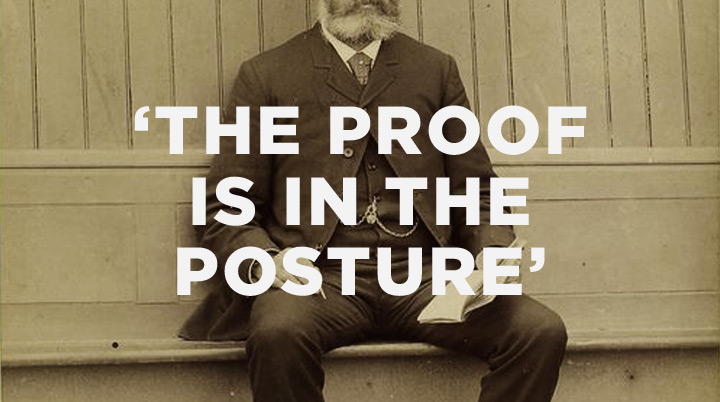Latest
-
Objections to the Christian Faith from the Unchurched and De-Churched
 Tue Dec 02, 2014
Tue Dec 02, 2014
by Resurgence -
Craig Groeschel: We Innovate for Jesus
 Tue Oct 14, 2014
Tue Oct 14, 2014
by Resurgence -
Mark Driscoll: Revelation
 Tue Oct 07, 2014
Tue Oct 07, 2014
by Resurgence -
RESURGENCE LEADERSHIP #034: JOHN PIPER, WHY I TRUST THE SCRIPTURES, PART 2
 Tue Sep 30, 2014
Tue Sep 30, 2014
by Resurgence -
Resurgence Leadership #033: John Piper, Why I Trust the Scriptures, Part 1
 Tue Sep 23, 2014
Tue Sep 23, 2014
by Resurgence

Archives
‘The proof is in the posture’: J.D. Greear talks with Mark Driscoll about salvation

Pastor Mark talks with J.D. about his latest book, Stop Asking Jesus into Your Heart: How to Know For Sure If You Are Saved.
Mark Driscoll: In the book you talk about how you “asked Jesus into your heart” countless times. Why so many false starts, and how did the truth finally click for you?
J.D. Greear: I never was sure I had gotten it right. Had I really been sorry enough for my sin that time around? Some wept rivers of tears when they got saved, but I hadn’t done that. Was I really sorry? And there were a few sins I seemed to fall back into over and over again, no matter how many resolutions I made to do better. Was I really sorry for those sins? Was that prayer a moment of total surrender? Did I really get grace?
So I would pray the sinner’s prayer again. And again. And again. And maybe get baptized again. Every student camp, every spring revival. Rinse and repeat.
I know it sounds a little poetic, but things really clicked for me my freshman year of college, when I read Martin Luther’s commentary on Romans. Luther points out that salvation comes by resting on the facts God revealed about the death of Christ. Just as Abraham was counted righteous when he believed that God would deal with his corruption, we are saved by believing that he has.
A wayward believer needs to be treated differently than a humble seeker.
The gospel is the declaration that Jesus is Lord and has made an end to our sins. We are saved by submitting to those two facts. Conversion is a posture we take toward the declarations that Scripture makes about Jesus. The point is not how we felt or what we said at the moment of conversion; the point is the posture we are in now.
In the book I compare conversion to sitting down in a chair. If you are seated right now, then you know that at some point in the past you made a decision to sit down—your posture proves it. If you are right now trusting in Christ’s finished work and submitting to his Lordship, that proves you are saved. If you are not, then it doesn’t matter what “ceremony” you went through. Assurance doesn’t come through a memory of a past event, but through our present posture. “Believing,” as it relates to assurance, is almost always presented in the present tense (e.g. 1 John 5:13).
MD: Your book addresses a huge question that Christians have wrestled with for centuries: the assurance of salvation. For our present-day context, how would you a respond to the average believer who comes up to you and asks, “How can I know that I’m saved?”
JG: It would, of course, depend on the situation of the person I was talking to, as a wayward believer needs to be treated differently than a humble seeker, but essentially I would ask them if their present posture is one of submission to Christ’s Lordship and trust in his finished work. If so, they are saved, even if they don’t remember the prayer or the moment they got into that posture. If not, then it doesn’t matter what prayer they prayed.
Second, I would ask them to consider whether the signs of eternal life are present in them. As John explains so thoroughly in 1 John, conversion does not bring sinless perfection, but it does begin to make fundamental changes in the human heart.
MD: How has your work as a pastor in a local church informed your theological position on salvation?
JG: I wrote this book for our church because of how many people struggle with assurance. I used to think I was alone in my doubts, but whenever I talked about this I would have such a slew of people tell me they had this experience that I concluded this was endemic.
I believe that part of the problem comes from the shorthand, clichéd ways we speak of the gospel. The usual evangelical shorthand for the gospel is to “ask Jesus into your heart” or to pray the “sinner’s prayer.” Shorthand is fine insofar as everyone knows what the shorthand refers to. But in our day “the sinner’s prayer” has often become a substitute for repentance and belief.
God doesn’t give salvation in response to a prayer.
To be clear—I am not trying to say that the sinner’s prayer is wrong in itself—after all, repentance and belief are in themselves a cry to God for mercy. Jesus presents the repentant tax collector being converted through the prayer, “God, be merciful to me, a sinner” (Luke 18:13). Some of the greatest evangelists in history—even Reformed ones—used a sinner’s prayer, including John Bunyan, George Whitefield, and Charles Spurgeon. Spurgeon would plead with people to pray the words of a sinner’s prayer after him as part of the conclusion to his sermons. I would go so far as to say that if you do not press for a decision when you preach the gospel, you haven’t fully preached the gospel, because the gospel in its very essence calls for a response. I’m not even against the language of asking Jesus into your heart, because—if understood correctly—this is a biblical concept (cf. Rom. 8:9–11; Gal. 2:20; Eph. 3:17)!
I am saying that the sinner’s prayer has become a Protestant ritual that people often go through without considering what the prayer is supposed to embody. God doesn’t give salvation in response to a prayer; repentance and faith are the instruments that lay hold of salvation. You can express repentance and faith in a prayer, but it is possible to repent and believe without a formal prayer, and it is possible to pray a sinner’s prayer without repenting and believing.
We have to get this right, because assurance of salvation is vitally important for the Christian life. Our spiritual lives will never take off until we have the assurance of our salvation. How can we let go of everything for Jesus until we know that Jesus really belongs to us? How will we ever embrace the pain of the cross if we are not assured of the joy of resurrection? I am concerned for many of our people who can’t surrender it all because they don’t have the joy of assurance.
Repentance and faith are the instruments that lay hold of salvation.
On the other hand, I am concerned for a lot of people in the Summit Church who are falsely assured of their salvation on the basis of a prayer they prayed that someone told them would punch their ticket for heaven. The group in Matthew 7 turned away from heaven with the terrifying words, “I never knew you; depart from me,” will all have prayed a prayer. This group must be woken up with the commands to repent and believe.
So I wrote this book, you might say, to comfort the unnecessarily troubled and trouble the unjustifiably comforted.
MD: What are some of your go-to passages in Scripture for someone who wants to learn more about what the Bible says about salvation?
JG: John 3:36 establishes that only two categories of people exist on earth: those who have believed (and obeyed) the Son, and those who have not. Each person necessarily fits into one category or the other. God used this verse to help me in my own struggle for assurance. I would also add Romans 4:5, “To the one who does not work but believes in him who justifies the ungodly, his faith is counted as righteousness,” which stresses the aspect of resting in Christ’s work on our behalf.
I know God can never say to me, “I never knew you.”
Another key passage is 1 John 5:10–13, which says (in part), “This is the testimony: that God gave us eternal life, and this life is in his Son. . . . I write these things to you who believe in the name of the Son of God so that you may know that you have eternal life.” These verses show us that God wants us to know where we stand with him, and establish for us the two ways we can know: (1) We believe in the name of the Son of God, and (2) We see the evidences of eternal life at work in us.
MD: Now that you have your own kids, how do you help them understand what their dad did not as a boy? What advice do you have for parents seeking to cultivate a “posture of repentance and faith” in their kids and lead them to a vibrant relationship with Jesus
JG: As a father of four young children, I have often reflected on the best way to lead them to faith. I want their decision to follow Jesus to be significant, but I also don’t want them to go through what I went through, constantly questioning my previous religious experiences. I know that when you present kids with a “Don’t you want to be a good girl and make Daddy happy and accept Jesus and not go to a fiery hell?” of course they say, “Yes.” “Praying the prayer” in such a situation may have little do with actual faith in Christ and have more to do with making Daddy happy.
For that reason, many parents don’t want to push their child to make a decision for Christ. What if we coerce them into praying a prayer they don’t understand, and that keeps them from really dealing with the issues later when they really understand it? Might having them pray the prayer too early on inoculate them from really coming to Jesus later, giving them false assurance that keeps them from dealing with their need to be saved?
I understand that fear. At the same time, I know that children are capable of faith. (In fact, Jesus tells adults that for them to be saved they must become like children, not visa versa!) And Jesus says that those of us who make it difficult for little kids to put faith in him ought to have a millstone tied around our necks and be thrown into the sea (Matt. 18:1–6). So I don’t ever want to discourage my kids from faith.
I want my kids’ minds to go to what Jesus did on Calvary.
The dilemma is resolved, however, by seeing salvation as a posture toward Christ and not as a ceremony. There is only one posture ever appropriate to Christ: surrendered to his Lordship, and believing that he did what he said he did. From the very beginning of their lives, I want my kids to assume that posture! So I explain to them often what Christ has done and encourage them to pin their hopes of righteousness on his work and not theirs. Whenever they think about their hopes for heaven, I want their minds to go to what Jesus did on Calvary. And when I encourage them to walk in holiness, I want the motivation—from day one—to be the finished work of Christ on their behalf.
Again, it’s like sitting down in a chair. If you’re sitting down now, that is proof that at some point you made the decision to sit down even if you don’t remember the moment. There was a moment you sat down, but the proof is in the present posture, not the past memory. The same is true with my kids and the Lordship of Jesus and his finished work. They can only be in one of two postures with him. So whenever I talk to them about Jesus, I encourage them to assume the posture of repentance and faith. Why would I ever want them to have a different posture in relationship to Jesus? Whether they can explain later the exact moment they sat down in repentance and faith is less important than the fact that they do it.
MD: What is the role of doubt when it comes to the gospel and faith?
JG: Charles Spurgeon used to say that doubt is like a foot poised to go forward or backward. Doubt can lead you backward into despair; it can also drive you forward into deeper and more intimate faith.
Doubt can lead you backward into despair.
Quite often looking into the mirror of the law makes us doubt that we are truly converted. It is, as Paul said, the schoolmaster that teaches us our need for Christ. Our doubts should drive us into the finished work of Christ for refuge. I think of what the songwriter said, “When Satan tempts me despair, and tells me of the guilt within, upward I look and see him there, who made an end to all my sin!”
For every one look we take at our sinful heart, we should take 10 looks at Christ. Once when Spurgeon was preaching on Matthew 7, he said, “He can never say to me, ‘I never knew you,’ for he has known me as his poor dependent, a beggar for years at his door. . . . Thou knowest me, Lord, for I came to thee, and said, ‘God be merciful to me a sinner.’ . . . Dost thou ask me who I am? ‘Once a sinner near despair, I sought thy mercy seat by prayer.’”
Doubt can also drive you forward into deeper faith.
I know God can never say to me, “I never knew you,” because to know him is to depend on his finished work as our salvation. So what Satan intended for evil (doubt), God uses for good to drive me deeper into the arms of Christ.
MD: In the book you say, “There are points you can never pass spiritually until you are confident that Jesus will support the full weight of your soul.” Can you describe some of those points for our readers? What does the progression of maturity look like—are we talking Varsity and JV?
JG: Truly following Jesus means saying “no” to a lot of things. It requires you to give away money you’d like to use and forego vengeance on those who have hurt you. To take up the cross means delivering yourself over to death. Death of control over your life. Death of your own dreams. And that death is empowered only by the promise of new life.
You will never have the strength to say “no” to sin until you realize the unconditional “yes” that God has given to you in Christ. You’ll never give up your life in radical obedience until you are radically assured of his radical commitment to you.
“Varsity” level obedience doesn’t come from having a will of iron, it comes from having such joy in what you know you possess in Christ that you would gladly let 10,000 worlds go to hold onto him (Matt. 13:44). What overcomes the world, John says, is our faith and joy in what we have in
To take up the cross means delivering yourself over to death.
J.D. Greear, Ph.D., is the Lead Pastor at the Summit Church of Raleigh-Durham, North Carolina. Pick up J.D's new book here.
